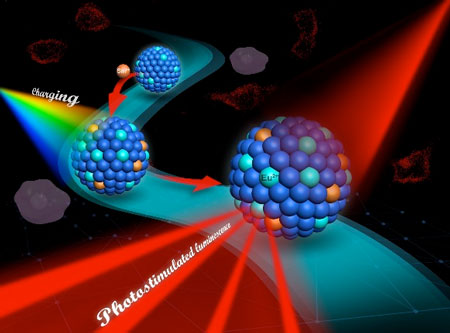| Jun 04, 2019 | |
Novel broadband near-infrared photostimulated luminescence nanoprobes(Nanowerk News) Photostimulated luminescence (PSL) phosphors can store short-wavelength excitation energy in traps and release it upon near infrared (NIR) light irradiation. NIR photostimulated luminescence nanoprobes have been proposed as a new type of fluorescent probes that can reduce autofluorescence and increase the tissue penetration depth in the field of biomedical applications. |
|
| In a study published in Chemical Science ("Broadband NIR photostimulated luminescence nanoprobes based on CaS:Eu2+,Sm3+ nanocrystals"), a research group led by Prof. CHEN Xueyuan from Fujian Institute of Research on the Structure of Matter (FJIRSM) of the Chinese Academy of Sciences reported a strategy for synthesizing novel broadband NIR photostimulated luminescence nanoprobes based on CaS:0.06%Eu2+,0.006%Sm3+ nanocrystals (NCs). | |
 |
|
| Schematic illustration of photostimulated luminescence for CaS:0.06%Eu2+,0.006%Sm3+ nanocrystals. (Image by Prof. CHEN’s group) | |
| Researchers synthesized the CaS:Eu2+,Sm3+ NCs via a novel high-temperature co-precipitation method. They systematically investigated the trap distribution, charging and discharging process and the mechanism of PSL of CaS:Eu2+,Sm3+ NCs. | |
| The results unveiled that Sm3+ co-doping increases the trap depth and thermal annealing eliminate the detrimental defects, which significantly improves the PSL of CaS:Eu2+,Sm3+ NCs. | |
| After thermal annealing, CaS:Eu2+,Sm3+ NCs showed a strong PSL of Eu2+ at 650 nm with a fast PSL response in a broad NIR region from 800 nm to 1600 nm and a duration time longer than 2 hours. Furthermore, the stimulation power density at 980 nm is less than 10 mW cm-2. | |
| By utilizing the unique PSL of CaS:Eu2+,Sm3+ NCs, researchers have demonstrated the application for receptor-targeted cancer cell imaging. The cytotoxicity of lipo-coated CaS:Eu2+,Sm3+ NCs against L-02 cells indicated that the nanobioprobes are biocompatible and nontoxic to live cells. | |
| This study provides a new method to synthesize RE-doped alkaline-earth sulfides (AES) nanocrystals and paves the way for the development of highly efficient NIR PSL nanoprobes toward versatile bioapplications. |
| Source: Chinese Academy of Sciences | |
|
Subscribe to a free copy of one of our daily Nanowerk Newsletter Email Digests with a compilation of all of the day's news. |
